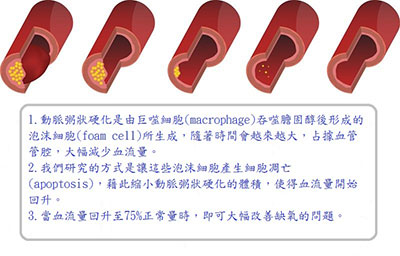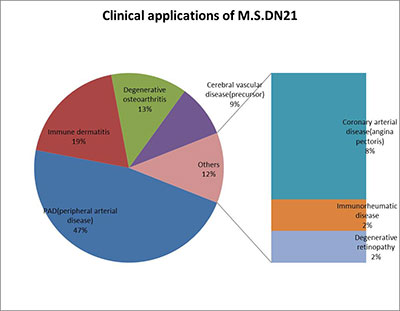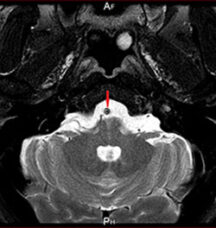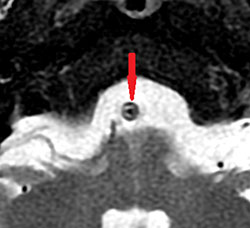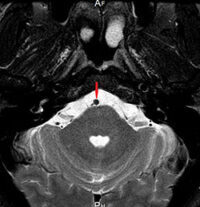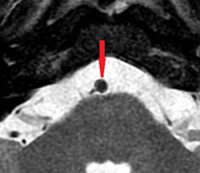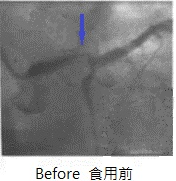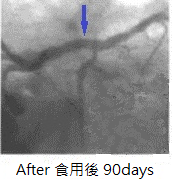Q&A Revascularization
A1:With the increase of age, atherosclerotic plaque (atheroma) in the blood vessel will cause the blood flow to decrease. When the blood flow is lower than 25% of the normal amount, the symptoms of local hypoxia are easy to appear, such as: pain, soreness, hair loss Numbness, weakness, inflammation, cyanosis, necrosis…etc. Severe vascular stenosis usually requires placement of a stent to expand blood flow and improve hypoxia. Vascular reconstruction is to solve this problem. In medical reconstruction, balloon dilatation or vascular stent placement can be used. Among them, vascular stents are expensive, and in some cases, more than two stents need to be placed at a time. The placement process is tedious and time-consuming, and the patient also requires hospitalization and medical care.
PS1:For traditional stents, the restenosis rate is 30-40%; for drug-coated stents, the restenosis rate is 10%; both of them have a 1% chance of acute obstruction and thrombosis.
PS2:The deductible for drug-applied vascular stents is about 2,200 dollars each.
Medically, it is believed that atherosclerotic plaques are irreversible lesions. Once they form, the only way is to reduce their growth rate and prevent the thrombus they cause from blocking blood vessels. Blood lipid-lowering drugs and antiplatelet drugs (anticoagulant drugs) It is a common prescription. Other health foods (gingko biloba, fish oil…) have not been studied in this area, and patients cannot change the fate of vascular stent placement after all, and some blood vessels may not be able to be placed with vascular stents.
血液淨化療程(血漿置換術)可以清除血液中的血脂肪、低密度膽固醇、自體免疫抗體、發炎物質、代謝性廢物…等等,但是對於已經形成的粥狀硬化斑塊是無效的。
For decades, our research has shown that the best way is to directly reduce the volume of atherosclerotic plaque, thereby increasing the local blood flow. When the blood flow increases from 25% to over 75%, the symptoms of local hypoxia can be significantly improved , the process can also repair the vascular endothelium and prevent thrombus generation. This method is also called “vascular reconstruction (revascularization)”. It is currently the simplest, most effective, non-invasive, and most economical method, and it is applicable to any part of the blood vessel, and any degree of stenosis. The only exception is that completely blocked blood vessels cannot be reconstructed.
According to statistical results, vascular reconstruction needs to last for 90 consecutive days (except for women’s menstrual period). During this period, if you cooperate with lifestyle and dietary adjustments, exercise, massage, and acupuncture, the reconstruction progress will be faster. The result of the reconstruction will be lifelong. After the vascular reconstruction is completed, we recommend maintaining it for 15 to 30 days every six months. This can keep the blood flow above 75% of the normal level forever, and avoid premature aging and decline of local tissues and organs due to hypoxia. In addition, our vascular reconstruction is systemic, not a single or partial vessel, so it is definitely more effective than stent placement.
As long as it is a blood or blood vessel-related disease, vascular reconstruction can be accepted, and it is helpful to a certain extent. According to our clinical test period (2004-2016), the indications for revascularization are as follows: (1) peripheral arterial occlusive disease: 47%; (2) immune-related dermatitis: 19%; (3) degenerative Osteoarthritis: 13%; (4) cerebrovascular disease: 9%; (5) coronary artery stenosis (angina pectoris): 8%; (6) immune rheumatic disease: 2%; (7) degenerative retinopathy: 2%. The cumulative number of complete cases has reached 305, and the overall effective rate is as high as 90%.
臨床上評估方式非常多,其中最簡單的是『症狀改善與否』,這是最主觀的感受,也是參與客戶最為驚豔的一點。再來就是影像學的檢查,通常我們會建議客戶在接受血管重建前,先到醫院確定診斷,保留完整的檢驗報告,等血管重建完成後,再回到該院做第二次檢驗,互相對照比較即可。
血管重建前(電腦斷層):血管截面積只剩25%以下(紅色箭頭)
血管重建後(電腦斷層):血管截面積擴大至75%以上(紅色箭頭)(90 days)
血管重建前(血管攝影):血液流量為TIMI 1(藍色箭頭)
血管重建後(血管攝影):血液流量為TIMI 3(藍色箭頭)
血管重建前(微血管攝影):360X(綠色箭頭)
After revascularization (microvascular photography): 360X (green arrow) (40 days)
A8:The following items are very important and must be carefully coordinated: (1) Except for women who encounter menstrual periods or encounter any major personal illnesses, do not interrupt the process arbitrarily, otherwise the progress of vascular reconstruction will be affected; (2) Sleep as much as possible (3) Eat carefully, eat less high-fat and high-sugar foods or drinks, and avoid raw and cold foods for the time being; (4) Cooperate with exercise, massage, hot compress or acupuncture to speed up the progress of blood vessel reconstruction.
A9:According to the research on the change of blood flow and the appearance of clinical symptoms, it is found that when the flow rate rises to more than 25%, the clinical symptoms will begin to reduce or disappear. The time required is about 30 days, but under good conditions, the time can be shortened to 21 days, even 14 days in the best record.
A10:As we all know, the skin is extremely related to the subcutaneous microcirculation. When the subcutaneous microcirculation improves, the skin will naturally receive abundant blood to moisturize and nourish. Therefore, the change of the skin is an inevitable phenomenon, so don’t be too surprised.
A11:At present, many constipation problems are caused by poor intestinal blood circulation, resulting in insufficient peristaltic power of smooth muscle, resulting in functional constipation. When the intestinal blood circulation is enhanced, the peristaltic force of smooth muscle will naturally increase, so the problem of functional constipation will be solved naturally

